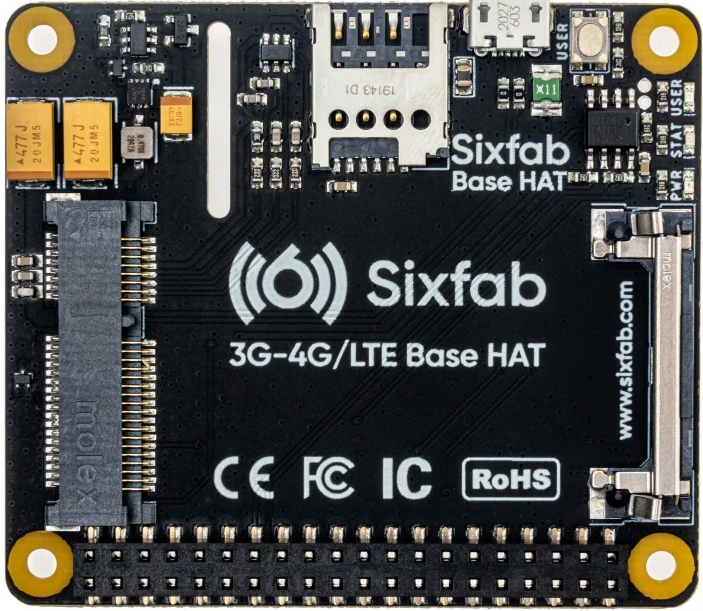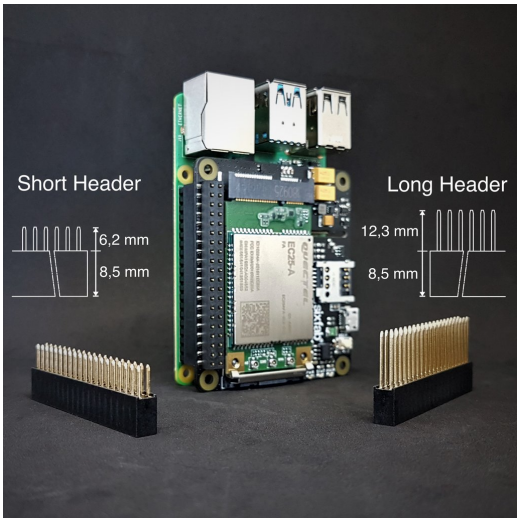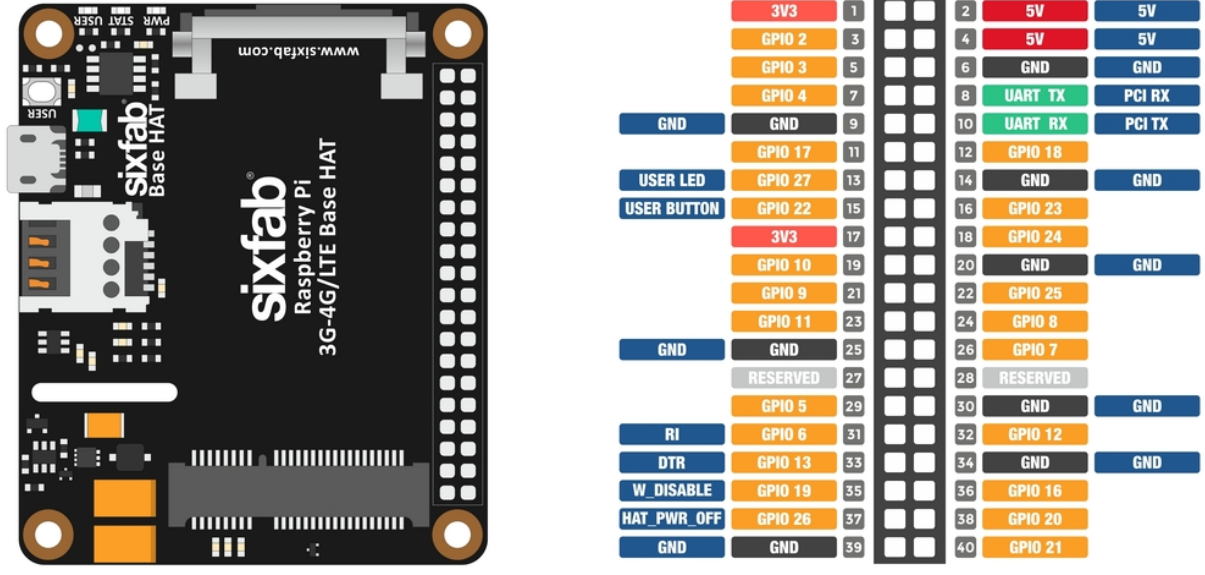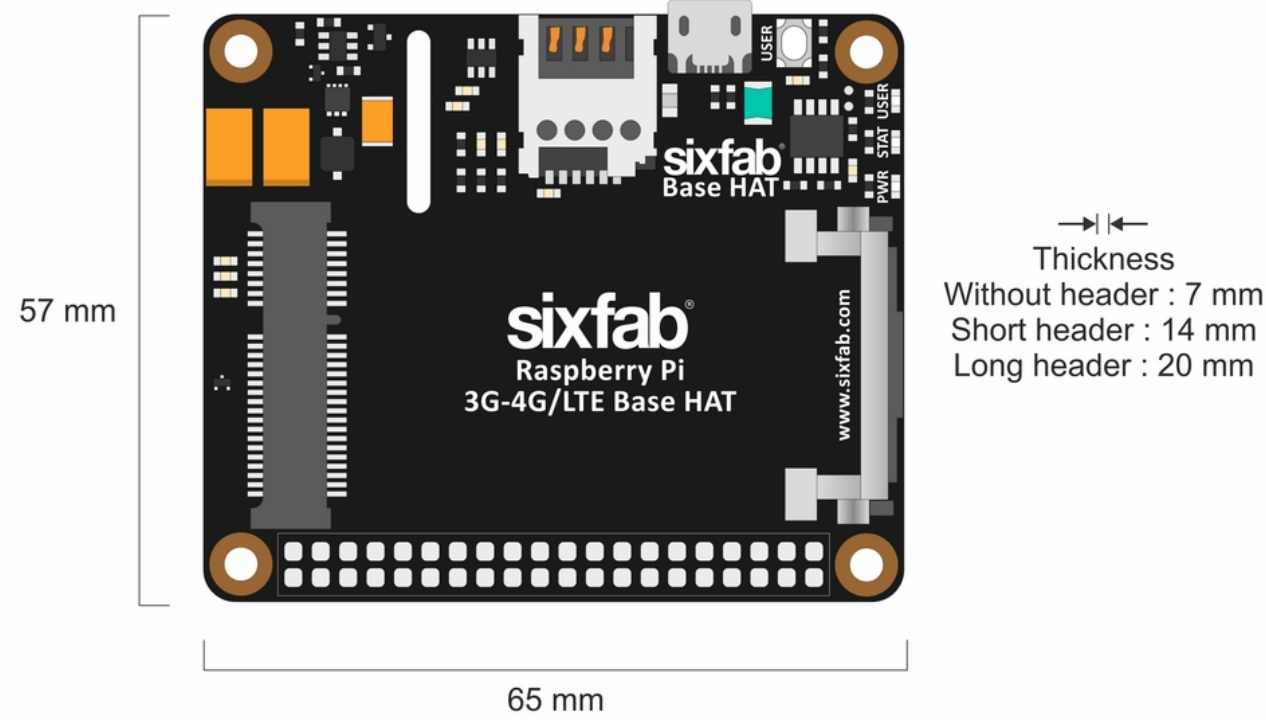Sixfab Raspberry 3G/4G & LTE Base HAT Manual

Content
Sixfab Raspberry Pi 3G/4G & LTE Base HAT Introduction
The Sixfab 3G/4G& LTE Base HAT grants your Raspberry Pi or 40-pin Pi compatible single-board-computer a super-simple interface bridge between mini PCIe cellular modems. With the modems you insert into Base HAT, your Raspberry Pi based projects will access data networks all around the world. This Base HAT enables high-bandwidth cellular connectivity on your remote devices. From low-power consumption LTE-M to ultra-high-speed LTE-Advanced mini PCIe cards supported by this HAT. Both UART and USB communication with modules is available on the shield.
Remote management of your devices on the field, secure connection over the mobile network, reliable coverage across the globe with lots of carrier option is available with this HAT stacked on the Raspberry Pi. It can be used as an LTE modem or dongle. If you’re looking for a Raspberry Pi LTE HAT for applications like Raspberry Pi video streaming or high-speed data transferring, you are at right place. Making a remote controllable LTE Wi-Fi Hotspot, high-speed GPS tracking, more and more use case is possible with his add-on board.
The Sixfab Base HAT is priced at $45.00.
Package Includes
- 1x Sixfab 3G/4G<E Base HAT for Raspberry Pi
- 1x 90-degree Right Angle Micro USB Cable
- 1x Long Header
- 1x Short Header
NOTE: The 3G/4G-LTE Mini PCIe modules are not included.
Detailed Specifications
The Sixfab Raspberry Pi 3G/4G & LTE Base HAT features a Quectel EC25-AF module that supports global 3G/4G/LTE bands. It also includes a u-blox NEO-M8N GPS module that provides accurate location data. The HAT has a micro-SIM card slot, a USB connector, and an antenna connector. It supports UART, I2C, SPI, and GPIO interfaces and consumes less than 1W of power. The Sixfab Raspberry Pi 3G/4G & LTE Base HAT measures 65 x 30 mm and weighs only 15 g, making it a compact and lightweight solution for your Raspberry Pi projects.
Features
- Fully compatible with Raspberry Pi models that have the 40-pin GPIO header (4, 3, 2, B+, A+, Zero)
- Easy-to-use, simple setup, plug-and-play
- QMI and PPP are supported
- Clip-in Mini PCIe socket compatible with worldwide LTE, UMTS/HSPA+, and GSM/GPRS/EDGE coverage with regional or global modules which work with di˙erent frequencies & carriers
- With the 4G/LTE Module(e.g Quectel EC25) you can reach 150Mbps downlink and 50Mbps uplink data rates. And the 3G Module( e.g Quectel UC20) delivers the maximum data rate of 14.4Mbps downlink and 5.76Mbps uplink.
- Micro SIM Card sockets can easily be reached on the upside of the HAT.
- Can be used standalone with a PC/Laptop over micro USB, without stacking with Raspberry Pi.
- The HAT can be powered from an external 5V source by exposed power pins, directly from Raspberry Pi 5V GPIO headers, via micro USB, or optional JST connector on the bottom of the board. A specially designed 90-degree right angle micro USB cable is included to package.
- Eÿcient and low quiescent current power circuits can hold up to 3Amps
- Optional Send/Receive AT commands over Raspberry Pi UART port are available
- Taking the module into the Airplane Mode, resetting the module or RI and DTR functions can be accessible over GPIO pins.
- The power of the whole board electronics can be disabled for low-power consumption use cases
- The modules(EC25&UC20) have built-in GNSS(GPS/GLONASS) receivers for your location-based applications.
- Working temperature range: -40°C ~ 80°C
Base HAT vs Base Shield V2
- Base HAT does not require to choose its header type, long, short or no header. It comes with an SMD header acceptable and short&long headers, you can stack it whatever you want.
- You can completely disconnect the power of HAT by driving GPIO26 to a HIGH-level voltage state. Then it starts to consume below 1 milliamp typically.
- USER LED is added and light up if you drive GPIO27 to HIGH.
- USER BUTTON added and pulled-up by default. When you push the button, you can sense a LOW level from GPIO22.
- Now, it can be called as a HAT not shield, complies with HAT requirements by Raspberry Pi Foundation.
- It has a slot for Pi Camera on board for easy mount.
- The location of the micro USB connector realigned. It is better now to use the right-angle micro USB cable included in the package without bending it too much.
- There is a new footprint for a surface mount right-angle JST connector on the bottom of the board for external 5V sources. It is not soldered by default.
- All GPIO pins used by HAT connected to Raspberry Pi IOs via normally-close jumpers. You can easily cut the connection on the bottom of the board if the pin occupied by another HAT you stacked on it.
Migration to Base HAT from Base Shield V2
The new HAT has better power circuitry and features than Base Shield V2. It is pin-to-pin compatible, your old setup will work with the new Base HAT right out of the box. You need only check the following points:
- On the Base Shield V2 the GPIO26 connected to PERST-PCI pin of the miniPCI pinout. It lets you reset the modem by changing the state of this pin. Now, this pin used for enabling/disabling of the power of HAT, that means you can reset the modem by cutting its power and enabling then.
- Two new IO pins, GPIO27 and GPIO22 populated by USER LED and BUTTON respectively by this new HAT. If you need these pins by your project, you can cut the jumpers on the bottom of the board easily. (SJ5 for the button, SJ6 for LED)
Key Applications
- Video/Music Streaming
- Large Data Downloads and Uploads
- LTE Dongle/Router
- Mobile Internet Hotspot
- High-speed GPS Tracking
- Real-time Environmental Monitoring
- Smart City & Agriculture Applications
- Smart Parking
- Security & Asset tracking
Header Options
The HAT comes with built-in SMD header acceptable and two headers with di˙erent lengths included in the package by default. You can choose the right version for the project and stack and use it immediately without soldering it.
- Long Header: If you plan to attach another Raspberry Pi HAT or add-on board on top of the Base Shield, you will definitely need this variation. Also, using GPIOs with jumper cables is possible with these male headers. If you need to stack another shield on top of Base HAT or still need to use GPIOs, the long header will be useful.
- Short Header: At the case you need the HAT as the slimmest possible, the short header will work like there is no header added length above the Raspberry Pi.
- Without Header: If just the plugging Base HAT via micro USB cable to Raspberry Pi is enough for you, or you’ve already attached a bulky shield on Pi, doesn’t need UART communication or IOs, headerless HAT works greatly. For knowing what you missing without headers, take a look at the Pinout Diagram of the HAT, these pins will be unconnected.
Figure 1: Raspberry Pi Base HAT Header Options

Technical Details
Connection Types
- USB: Most of Mini PCIe modules have USB driver for Android, Linux, and Windows operating systems. The Base HAT that loaded with a module like Quectel EC25 LTE, can be attached to a minicomputer(especially Raspberry Pi), mobile phone or laptop with USB then works as a 3G/4G USB Dongle Modem. Drivers for modules, please visit the module product pages.
- UART: If you insert one of the Quectel Mini PCIe modules, the UART pins will be available to use, with 3.3V power domain, directly connected the UART port of Raspberry Pi. But the maximum data rate will be lower than USB. It’ll be around 900 Kbit/s Downlink and Uplink (UART)
Compatible Mini PCIe Modules
- Quectel
- EC25 Mini PCIe 4G IoT Module
- EC21 Mini PCIe 4G IoT Module
- EC20 Mini PCIe 4G IoT Module
- UC20 Mini PCIe 3G IoT Module
- Quectel
- LTE-EP06
- Sierra
- AirPrime MC Series
- Telit
- LM960, LE910V2, HE910, LE910Cx, and more
- Huawei
- ME909s-120, ME909s-821, and more
- Simcom
- SIM7100, SIM7230, and more
- ZTE
- ZM8620, and more
- U-Blox
- MPCI-L2 Series
Important Note(*): Please check the following Quectel Mini PCIe pinout(EC20, EC21, EC25, UC20) diagram and the Base HAT connected pin table for full compatibility. The other Mini PCIe modules from different vendors can be used with the Base HAT. Generally, these modules’ USB, power supply, status LED and SIM Card pins match with Base HAT Pinout, they can be used via USB connection without struggling but it does not mean full compatibility, some features may not work. The AT Command Interface cannot be used without a UART connection. Please, consider that USB connection needs special drivers for each operating system.

Figure 2: Quectel Legacy Mini PCIe Pinout
Sixfab Base HAT Mini PCIe Pinout | Quectel EC20,EC21,EC25,UC20 | Quectel LTE-EP06 | Sierra Telit Huawei Simcom ZTE U-Blox |
Pin[8] USIM VDD | OK | OK | OK |
Pin[10] USIMDATA | OK | OK | OK |
Pin[11] UART_RX | OK | NOT CONNECTED | NOT CONNECTED |
Pin[12] USIMCLK | OK | OK | OK |
Pin[13] UART_TX | OK | NOT CONNECTED | NOT CONNECTED |
Pin[14] USIMRST | OK | OK | OK |
Pin[17] RI | OK | NOT CONNECTED | NOT CONNECTED |
Pin[20] W_DISABLE | OK | OK | OK |
Pin[22] PERST | OK | OK | OK |
Pin[31] DTR | OK | NOT CONNECTED | NOT CONNECTED |
Pin[36] USB_DM | OK | OK | OK |
Pin[38] USB_DP | OK | OK | OK |
Pin[42] LED_WWAN | OK | OK | OK |
Description
The Sixfab Raspberry Pi 3G/4G & LTE Base HAT is a high-quality add-on board that allows you to connect your Raspberry Pi to the internet via cellular networks. It provides fast and reliable connectivity with low latency and high throughput. The HAT also includes a GPS module that can be used for location-based applications and geolocation services. The Sixfab Raspberry Pi 3G/4G & LTE Base HAT is easy to install and use, with a simple setup process and a user-friendly interface. It is compatible with a wide range of Raspberry Pi models and is supported by a large community of developers and users.
Compatible Boards
- Raspberry Pi 3, 2, B+, A+, Zero
- Asus Tinker Board
- Rock 64*
- Orange Pi*
- Samsung ARTIK’s Eagleye board
- Latte Panda
Note 1: The modules’ default drivers may not work with all these mini computers. There may need some Kernel work to implement the drivers. We’re working on Quectel Modules’ drivers to make them ready for each mini computer in the list. Please take a look at our support section for details.
Note 2: This compatibility list created by assuming you’ve connected the Base HAT to the device via USB. UART communication can be work with every device in the list easily which have 3.3V level UART port.
Warnings
- For the best working condition, use at least a 2A adapter or power source.
- We don’t recommend usage of long and low-quality micro USB cables between Base HAT and Raspberry Pi. It causes data and power loss. Thus, the cable included the package works greatly.
Sixfab Raspberry Pi 3G/4G & LTE Base HAT Electrical
Pinout

Layout

Pin Descriptions
Pin Number | Pin Name | Description |
2 | 5V PWR | This pinis connected to the 5V power net |
4 | 5V PWR | This pinis connected to the 5V power net |
8 | PCI RX | This pin functions as the serialdata input to the modulefor UART communication |
10 | PCI TX | This pin functions as the serialdata output fromthe module for UART communication |
13 | USER LED | It is a programmable user-led can control from Raspberry Pi |
15 | USER BUTTON | This pushbutton connected to Raspberry Pi and pulledup HIGH state by default. |
31 | RI | This pin is Ring indicator functions as the indicationfor receiving call or SMS, can be calibrated to HIGH or LOW usingthe AT commands |
33 | DTR | When the module is in sleepmode, DTR pin allows to wake up the module up by pulling it to LOW |
35 | W_DISABLE | This pin is used to turn Airplane Mode on the module, by pulling it HIGH |
37 | HAT_PWR_ | The pin is used to shutdown the power regulator of the board and cut the power of module by driving it HIGH state,can be usedpower sensitive applications |
6,9,14,25,30,34,39 | GND | This pinsare connected to ground |
Schematic
You can download the schematic of Base HAT from this Github repository.
LEDs
- PWR LED: When the module is powered up, this RED led turns on.
- SGNL LED: This BLUE led indicates the status of the connection. When the connection is established and data is being transmitted/received, this led will blink at special intervals. Otherwise, if there is no connection, the led will remain o˙.
- USER LED: It is a programmable user-led can control from the GPIO27 of Raspberry Pi for debugging or just fun.
Mechanical
Dimensions

Figure 5: Sixfab Base HAT Dimensions
3D Design Files
You can download the 3D design files(STEP) of Base HAT from this Github repositoryhttps://github.com/sixfab/Sixfab_RPi_3G-4G-LTE_Base_HAT/tree/master/3d_files).
Weight
Header Type | Without Mini PCIe Module | With Mini PCIe Module | Unit |
Without Header | 18.3 | 28.4 | gr |
With Short Header | 21.6 | 31.7 | gr |
With Long Header | 25.1 | 35.2 | gr |
Setup Guide
To set up the Sixfab Raspberry Pi 3G/4G & LTE Base HAT, follow these steps:
- Insert the SIM card into the micro-SIM card slot.
- Connect the HAT to the Raspberry Pi GPIO pins.
- Connect the antenna to the antenna connector.
- Power on the Raspberry Pi and open a terminal window.
- Install the Sixfab modem driver and software using the command: "curl -sSf https:// Sixfab.com/install | sudo sh"
- Run the command "sudo sixfab modem list" to check if the modem is detected.
- Configure the network settings using the "sudo nmtui" command.
- Test the internet connection using the "ping" command.
Sixfab Raspberry Pi 3G/4G & LTE Base HAT Instructions
You may find your questions in F.A.Q under the support menu. If not, please feel free to ask us by contact form or drop an email to hello [at] sixfab dot com.
Tutorials
- Make a PPP internet connection with 3G, 4G/LTE HATs on Raspberry Pi
- Using Sixfab 3G or 4G Raspberry Pi HAT as a Wi-Fi Hotspot
- Raspberry Pi Youtube/Facebook Live Video Streamer with Sixfab 3G/LTE HATs
- Raspberry Pi Twitter Bot with Sixfab GPRS/3G/LTE HAT
- Raspberry Pi Security System with Sixfab 3G/LTE HATs
- GPS Tracker with 3G, 4G/LTE HAT
GitHub Repository
The Sixfab Github Repository for Raspberry Pi HAT contains the libraries and codes are used in tutorials, hardware files and more.
Troubleshooting
If you encounter any issues with the Sixfab Raspberry Pi 3G/4G & LTE Base HAT, try the following troubleshooting steps:
- Check if the SIM card is properly inserted and activated.
- Make sure the antenna is connected and positioned correctly.
- Check if the HAT is properly connected to the Raspberry Pi GPIO pins.
- Restart the Raspberry Pi and try again.
- Update the modem driver and software to the latest version.
Pros & Cons
Pros
- Fast and reliable 3G/4G/LTE connectivity
- Easy to install and use
- Compatible with a wide range of Raspberry Pi models
- Includes GPS module
- Low power consumption
Cons
- Expensive compared to other Raspberry Pi expansion boards
- Requires a SIM card and data plan
- Limited availability in some regions
- May require additional accessories such as an antenna
Customer Reviews
The Sixfab Raspberry Pi 3G/4G & LTE Base HAT has received positive reviews from customers, with an average rating of 4.5 out of 5 stars. Users have praised the HAT for its fast and reliable connectivity, easy setup process, and compatibility with various Raspberry Pi models. However, some users have reported issues with the SIM card activation and limited availability in certain regions. Overall, the Sixfab Raspberry Pi 3G/4G & LTE Base HAT is a highly recommended add-on board for Raspberry Pi users who need fast and reliable cellular connectivity for their projects.
Faqs
What is the Sixfab Raspberry Pi 3G/4G & LTE and how does it work?
What models of Raspberry Pi does the Sixfab Raspberry Pi 3G/4G & LTE Base HAT support?
How do I install the Raspberry on my Raspberry Pi?
How do I configure the network settings on the Sixfab Raspberry Pi 3G/4G & LTE Base HAT?
What is the range of the antenna for the Sixfab?
What is the power consumption of the Sixfab Raspberry Pi 3G/4G & LTE Base HAT?
Can I use the Sixfab Raspberry Pi 3G/4G & LTE Base HAT for voice calls and SMS messages?
What are the dimensions of the Sixfab Raspberry?
Where can I buy the Sixfab Raspberry?
Leave a Comment
